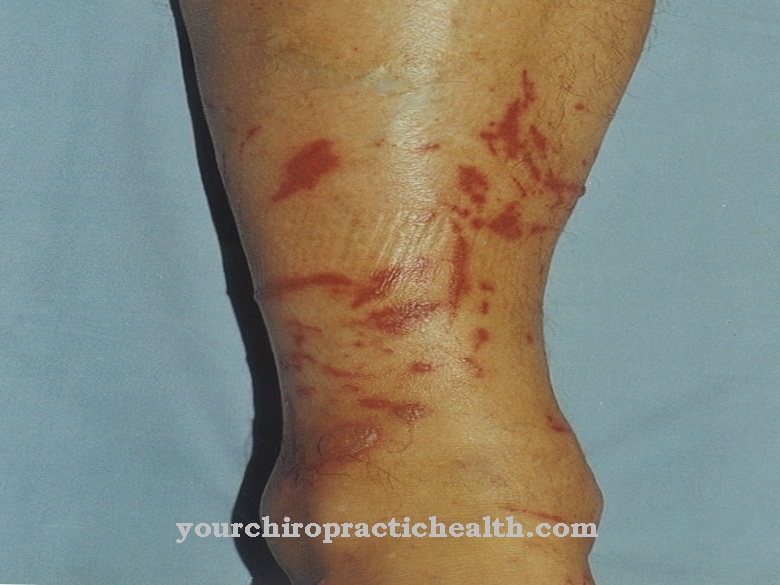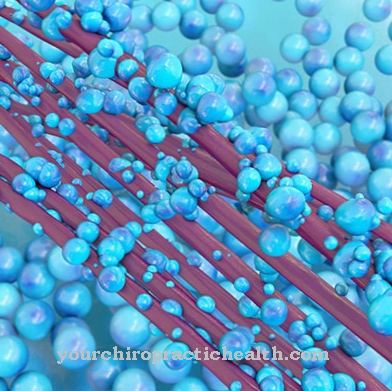The Walker-Warburg Syndrome is an extremely rare hereditary disease, the effects of which affect the brain as well as the eyes and muscles. The symptoms, which can already be recognized at birth, usually lead to the death of the affected and therefore severely disabled children after just a few months. So far there is no form of therapy to treat or even cure Walker-Warburg syndrome.
What is Walker-Warburg Syndrome?
The Walker-Warburg Syndrome (WWS) was named after Arthur Earl Walker and Mette Warburg and was first described by them in 1942. Out of around 40,000 newborn children, an average of one suffers from this very rare hereditary disease.
Walker-Warburg syndrome is a serious form of lissencephaly (derived from the Greek “lissos”, which means smooth), in which the normally furrowed cerebral cortex has a smooth surface. Walker-Warburg syndrome is caused by a defective development of the nerves in the cerebellum. This malformation of the brain leads to serious symptoms, which in the affected newborns often cause the formation of a so-called hydrocephalus, but also malformations of the eyes and the so-called cleft lip and palate as well as breathing problems.
This is why most of the newborns with Walker-Warburg syndrome are ventilated immediately after birth. However, many children are born dead due to Walker-Warburg syndrome.
causes
The cause of the Walker-Warburg syndrome lies in a multiple gene mutation, whereby the genetic defect is due to different chromosomes. Walker-Warburg syndrome is one of the autosomal recessive hereditary diseases.
This means that the altered genes have no gender-specific characteristics (autosomal) and the existing gene alteration only leads to Walker-Warburg syndrome if both father and mother pass this predisposition to their child (recessive).
The hereditary disease only breaks out if both parents have a genetic defect and pass it on to the child, whereby even in this case only around 25 percent of newborns actually develop Walker-Warburg syndrome.
Symptoms, ailments & signs
The disease shows numerous severe symptoms. There is lissencephaly, which means that the furrows and convolutions of the cerebral cortex are missing or only rudimentary. The cerebellum is significantly reduced in size. The malformations cause reduced growth and pronounced functional disorders of the muscles, so that the limbs hang limply on the body.
The children do not learn to move, crawl or walk and they cannot change their position on their own. They remain at the infant stage in their development. Breathing problems often occur immediately after birth. The food intake is difficult, they always have to be fed.
Since they inhale the food rather than swallow it, this leads to increased lung infections (aspiration pneumonia). The little ones perceive their surroundings, but cannot follow moving objects or people's movements with their eyes. The eyes are not developed normally, and the children are often blind or have a star. They cannot speak and there is usually a cleft lip and palate.
Hearing is also impaired. In some people, excessive fluid build-up in the cerebral ventricles causes hydrocephalus to form. A fluid-filled bulge on the back of the head (encephalocele) can also develop. The mental abilities are severely impaired by the severe malformations of the brain. Often the children suffer from epileptic seizures.
Diagnosis & course
To that Walker-Warburg Syndrome To diagnose, the pediatrician or other specialist staff will use magnetic resonance or computed tomography to determine whether it has hardened if there is any suspicion (due to the typical symptoms already present after birth).
In order to get an absolutely reliable diagnosis as to whether the child actually suffers from Walker-Warburg syndrome or from another disease with similar symptoms, the child is also subjected to a blood test. Walker-Warburg syndrome can also be diagnosed in cases in which both parents are known to have a genetic disorder by taking amniotic fluid prenatally, which is then genetically examined.
Ultrasound examinations are also used in the case of prenatal suspicion of Walker-Warburg syndrome, but only provide information on a general malformation of the brain, but not for a reliable diagnosis of this hereditary disease.
Walker-Warburg syndrome is fatal in its severe form, with many of the affected newborns being born dead. Live births with Walker-Warburg syndrome usually only stay alive for a few months, with the milder form of the disease a maximum of two to three years.
Complications
Walker-Warburg syndrome is associated with severe malformations and therefore also with severe restrictions in the everyday life of the person affected. As a rule, those affected suffer from a cleft palate, so that discomfort can arise when taking food and liquids. Dehydration or other deficiency symptoms can also occur due to Walker-Warburg syndrome and make everyday life difficult for the patient.
Furthermore, there is also a head of water and in many cases breathing difficulties and a significantly reduced brain. Most patients also have visual problems or pain in their eyes due to the condition. Mental and psychological complaints are also not uncommon in Walker-Warburg syndrome and have a very negative effect on the patient's quality of life.
In many cases, the patients are therefore dependent on the help of other people in their everyday life and can no longer easily carry out many everyday tasks. The parents or relatives can also be affected by psychological complaints. Since a causal treatment of Walker-Warburg syndrome is not possible, only the individual symptoms can be treated. There are no particular complications. Whether the Walker-Warburg syndrome leads to a reduced life expectancy in patients cannot be universally predicted.
When should you go to the doctor?
If you have Walker-Warburg syndrome, you should definitely contact a doctor. Since this is a hereditary disease, it cannot heal independently, and a complete cure is not possible anyway. However, an early diagnosis always has a positive effect on the further course of the disease, so that the person affected should contact a doctor as soon as the first symptoms of Walker-Warburg syndrome appear.
In most cases, however, the affected children die a few months after birth, so that parents and relatives in particular should consult a psychologist to prevent depression and other psychological disorders. The syndrome is usually diagnosed before birth.
A doctor should be consulted if the child suffers from breathing difficulties or hearing problems. Various malformations and malformations occur in the face, which can also indicate this disease. Since the treatment of this syndrome can be purely symptomatic, the symptoms cannot be completely alleviated, so that the child dies prematurely.
Treatment & Therapy
The treatment of the Walker-Warburg Syndrome Affected children are limited to artificial respiration by the medical staff immediately after birth as well as to the loving and sensitive handling of the infant or toddler born with Walker-Warburg syndrome on the part of the parents and relatives, as so far neither for the causes An effective form of therapy has yet to be found for the effects of this hereditary disease.
During the mostly very short life of their child and especially afterwards, the parents and survivors affected by Walker-Warburg syndrome can give themselves comfort, support and help in self-help groups, because processing falls within these groups, which have arisen through similar experiences and grief processes the effects caused by Walker-Warburg syndrome to find your way back to a "normal" life.
prevention
Basically exist for that Walker-Warburg Syndrome no preventive measures to avoid the disease. However, in the case of a genetic defect that is already known in both parents, but also in the event of any abnormalities within the family or in high-risk pregnancies, prenatal diagnostics can help to identify Walker-Warburg syndrome at an early stage, so that the parents and the environment can focus on the upcoming Prepare for the course of the disease and the unavoidable consequences associated with it.
Aftercare
Since Walker-Warburg syndrome cannot be treated causally and inevitably leads to infant death within the first years of life, follow-up care is not possible for the affected patients. The development of Walker-Warburg syndrome is, however, hereditary. Follow-up treatment is therefore aimed at the parents and close relatives of the affected child, especially siblings.
In the event of a new pregnancy, the parents should have a prenatal diagnosis carried out in order to be able to identify at an early stage whether the child is also affected by Walker-Warburg syndrome. If this is the case, the pregnancy can be terminated early if the parents so wish. Special counseling centers for pregnancy conflict counseling help to support decision-making.
In any case, prenatal diagnosis provides certainty about the health of the unborn child. In addition, psychotherapeutic accompaniment can be helpful for the parents of a child affected by Walker-Warburg syndrome in order to cope with the personal stress that the parents experience as a result of the child's illness.
If one of the parents becomes depressed, drug therapy with antidepressants may also be indicated. Healthy relatives and siblings of a person affected by Walker-Warburg syndrome should have a genetic test carried out to find out whether they are carriers of traits. If this is the case, prenatal diagnostics should also be carried out for all pregnancies of siblings of an affected child.
You can do that yourself
This serious, genetically determined disease offers hardly any scope for improving the overall situation for all those affected. Rather, self-help lies in dealing with the disease. In most cases, the patient dies within a few weeks or months due to the wide range of symptoms.
In order to alleviate existing health irregularities, it is important to work with the treating doctors. The support of a psychotherapist can be perceived as helpful in coping with the illness, especially by relatives. It is advisable to deal openly with one's own feelings and ideas so that the behavior of the parents can be better understood by all those involved. In many cases there are conflicts and interpersonal problems among family members because the emotional burden is enormous. However, these should be avoided under all circumstances so that the remaining life cycle can be optimized for the patient.
A harmonious solution is recommended when further medical treatment steps are taken. Pursuing one's own interests can lead to complications and an additional deterioration in health developments. In situations of excessive demands, the relatives should seek help immediately. An acute health development can occur at any time, for which everyone involved should be internally prepared.

.jpg)


.jpg)
.jpg)






.jpg)



.jpg)










.jpg)
